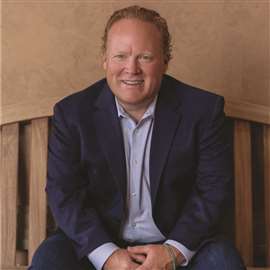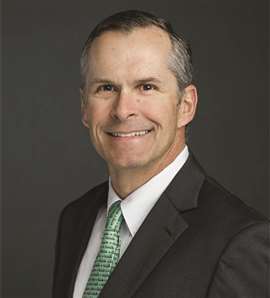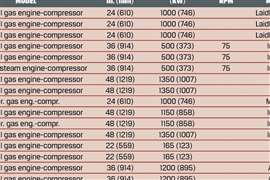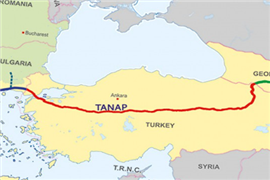November 03, 2025
Executives from BHE Compression Services, Kodiak Gas Services and FW Murphy Production Controls discuss technology, labor and the road ahead

The compression industry is entering a pivotal period as natural gas demand accelerates both domestically and abroad. U.S. LNG export expansion, rising power generation needs from AI-driven data centers, and ongoing decarbonization efforts are reshaping expectations for performance, reliability and emissions.
To understand how leading companies are navigating these trends, COMPRESSORtech2 spoke with executives representing three distinct perspectives: Mike Robbins, CEO of Berkshire Hathaway Energy Compression Services (BHE Compression Services); John Griggs, CFO of Kodiak Gas Services; and the new CEO of FW Murphy.
Their insights reveal a common thread: the next decade of gas compression will be defined by workforce readiness, supply-chain resilience, and smarter, lower-emission technology.
Mike Robbins, BHE Compression Services
CEO sees long-term growth in large-horsepower compression and low-emission technology
CT2 spoke with Mike Robbins, president and CEO of Berkshire Hathaway Energy Compression Services (BHE Compression Services), about market momentum for large-horsepower compression, supply-chain challenges, and the company’s CleanMachine technology designed to lower methane intensity.
Michael Robbins brings more than 25 years of experience in compression and gas operations. A co-founder of TCB Energy Services, he previously held leadership positions at USA Compression, Universal Compression and Exterran, and began his career at Red Cedar Gathering. Robbins studied electrical engineering at the Colorado School of Mines.
 Mike Robbins
Mike Robbins
CT2: As the industry navigates both energy transition pressures and growing global gas demand, how do you see the role of compression services evolving over the next decade?
Robbins: Large-horsepower compression services demand will continue to grow over the next decade in support of increased domestic needs, AI and data centers, and overall electrification, as well as international consumption tied to LNG exports. At the same time, we must continue working to lower the environmental impact of our operations, especially in emissions reduction, regardless of regulatory pressure.
CT2: Large-horsepower compression often comes with unique reliability and maintenance demands. What are the biggest operational challenges you see today, and how is your team addressing them?
Robbins: The largest operational challenge is finding qualified technicians. Partnerships are an extremely important part of ensuring we have adequate, experienced staffing to support our customers’ operations. Our strong partnership with TCB Energy Services gives us guaranteed access to a highly skilled, multifaceted staff. This has been key to supporting our growth and supplementing our internal team when unique skill sets are required.
CT2: The compression sector, like much of the energy industry, faces challenges around equipment lead times, skilled labor availability and broader economic volatility. How are these factors influencing your growth plans and ability to deliver for customers?
Robbins: Post-COVID, execution by some key vendors has had a huge impact on our growth potential and that of our customers. Equipment delivery for engine-driven packages has sometimes been delayed by six months or more, pushing new package lead times out to 60 to 90 weeks in extreme cases. Our strategy is to maintain a reasonable level of inventory for both current and potential customers, which helps offset some of these impacts—but certainly not all.
CT2: BHE Compression has promoted its CleanMachine technology as a breakthrough in reducing methane and combustion emissions. What makes this system different, and how is it changing customer expectations?
Robbins: The CleanMachine focuses on three things: eliminating methane emissions where possible, capturing what cannot be eliminated, and continuously monitoring system performance. That allows us to provide a real-time methane intensity number for our equipment. We also provide annual emissions testing and GHG certifications as part of our service.
Year-to-date 2025 data, validated by GHG certifications, show a fleet performance more than 40% lower in methane intensity than a conventionally designed compressor package. This technology was built into our fleet from the beginning—every unit includes it as standard.
CT2: Many midstream and upstream operators are under pressure to reduce methane intensity. How do you help customers meet these goals while maintaining reliability and cost competitiveness?
Robbins: Our team worked hard to lower total methane intensity while keeping capital costs similar to other fleet designs. That means we can bring this solution to market at competitive rates, not a premium. Our methane-focused diagnostics also provide preventive maintenance insights that improve run time. The way we see it, if a customer can have lower methane intensity for the same cost, why would they choose anything else?
CT2: With methane reduction becoming a focus for both regulators and investors, how do you see policy and market pressures shaping demand for low-emission compression in the next five years?
Robbins: Regulatory swings can create uncertainty, but our approach is to make smart, long-term decisions that are environmentally responsible and cost competitive. Ultimately, reducing emissions is the right thing to do, regardless of political shifts. Our team’s work is paying off—we’re seeing it in the momentum of the business and in the market share BHE Compression Services is winning.
 John Griggs
John Griggs
CFO discusses electrification, AI and the road ahead for LNG-driven growth
CT2 sat down with John Griggs, executive vice president and chief financial officer of Kodiak Gas Services, to talk about electric-drive compression, the integration of CSI Compressco, workforce development, and the long-term outlook for LNG demand.
Griggs joined Kodiak in 2023 after serving as CFO at Circulus Holdings, Conquest Completion Services and Rubicon Oilfield International. He previously worked in energy private equity at CSL Capital Management and D.E. Shaw Group, and began his career as an investment banker at Simmons & Co. International.
CT2: What demand are you seeing for electric-drive compression versus gas-drive, particularly in the Permian Basin where ERCOT transmission capacity is tight?
Griggs: It’s one of the questions we get most often. Kodiak focuses primarily on large-horsepower compression—1,000 horsepower and above. Electric compression adoption has been more prevalent in smaller-horsepower applications, typically 800 horsepower or less.
When you move into higher horsepower, the power consumption and voltage requirements are substantial. If a customer doesn’t already have grid access, building out last-mile electrical infrastructure can be costly. That’s a hurdle for many midstream operators weighing electric versus gas drive.
That said, the trend is real. About 40% of our new horsepower in 2025 is electric, and 2026 looks similarly strong. Larger customers with ESG commitments continue to push electrification, but smaller independents are taking a more case-by-case approach given the current regulatory climate.
CT2: Kodiak made headlines with the acquisition of CSI Compressco. What have been the biggest challenges in integrating those assets?
Griggs: The acquisition has been a home run strategically and financially, but it brought challenges.
The first was non-core horsepower. Kodiak has always followed a “Southwest Airlines model” of a standardized fleet. CSI had a more diverse fleet, including smaller units and international operations. Exiting those areas took time and effort.
Second, we needed to modernize the fleet. We invested about $15 million to convert remaining CAT 3516 ULB engines to J configurations, which is now essentially complete.
Third, culture. We developed a companywide “greenprint” of refreshed mission, vision and values to unify more than 1,300 employees. Finally, systems integration—our new ERP platform provides a single source of truth and the foundation for future AI applications.
CT2: You mentioned artificial intelligence. How is Kodiak approaching AI adoption?
Griggs: AI is a big focus for us, both in structured industrial projects and grassroots productivity tools.
On the industrial side, we’re working with Bright AI to build systems that improve efficiency in labor and equipment management. One example is a large language model tailored to Kodiak’s fleet that helps technicians troubleshoot faster in the field.
We’re also deploying advanced sensors that monitor performance and enable predictive maintenance. As those systems learn, they become smarter and increase horsepower-per-technician efficiency—a key metric in our model.
CT2: Labor remains a challenge across the compression industry. How are you addressing it?
Griggs: People are always the governor on our growth. We recruit aggressively through technical schools and run one of the most comprehensive training programs in the industry—BEARS Academy. Our IGNITE program brings in younger employees, trains them through BEARS, pairs them with mentors, and places them where they’re most needed. It’s a proactive, pipeline-based approach to workforce development.
CT2: LNG exports are expanding rapidly. How do you see Kodiak positioned over the next five years?
Griggs: The outlook is very strong. Roughly 70% of our horsepower is in the Permian Basin, which benefits from oil, gas and NGL revenues. We compete on reliability, not price—uptime is our brand.
Looking forward, LNG is the key driver. The U.S. LNG buildout underway through the 2030s will require massive new compression capacity, and Kodiak is well positioned to support that demand.
CT2: Finally, what keeps you up at night?
Griggs: Labor and energy policy. Compression assets have 30- to 40-year lifespans, so stable, rational policy is critical. The industry needs balance—recognizing hydrocarbons will remain essential while advancing environmental responsibility and reliability of supply. The uncertainty created by political swings is what keeps me up at night.
 Levent Caglar
Levent Caglar
New VP/GM focuses on execution, smart controls and sustainable growth in compression
CT2 spoke with Levent Caglar, who became VP/GM of FW Murphy in August, about his leadership priorities, the company’s path forward in controls and automation, and the technologies reshaping natural gas compression.
Caglar joined FW Murphy following leadership roles at Caterpillar and CSI Compressco, bringing deep experience in both equipment manufacturing and contract compression. In his new role, he is focused on aligning FW Murphy’s engineering and commercial strategies to accelerate innovation, strengthen customer relationships and expand the company’s footprint in emissions-compliant and digital control solutions.
CT2: You’ve worked with major players like Caterpillar and CSI Compressco. What lessons from those roles will you bring to FW Murphy?
Caglar: My time at Caterpillar and CSI Compressco gave me a front-row seat to what operational excellence and customer-centric strategy truly look like. At FW Murphy, I’m focused on execution with precision — aligning our engineering resources with our customers’ most important initiatives.
Both of my previous roles required constant coordination between engineering, sales and product teams. I’ll bring that collaborative mindset here to ensure our strategic initiatives are aligned across departments and driven by shared goals. Ultimately, I’m here to help FW Murphy scale with intention — building systems, teams and strategies that deliver lasting impact.
CT2: How is FW Murphy’s technology evolving to help operators reduce emissions, improve uptime and optimize fleet performance?
Caglar: FW Murphy’s technology is evolving in direct response to the industry’s most pressing challenges, and I see three major areas where we’re making a strategic impact.
First, reducing emissions through smarter controls. Our turnkey Engine Integrated Control System (EICS) allows customers to optimize engine performance while maintaining emissions compliance. These solutions help operators meet regulatory standards without compromising performance.
Second, improving uptime with predictive intelligence. Our remote monitoring platforms — including M-LINK and Centurion — give operators real-time visibility into asset health. That means faster diagnostics, fewer unplanned shutdowns, and smarter maintenance planning, all of which drive uptime.
Finally, optimizing fleet performance with data-driven insights. By integrating IoT-enabled controls and analytics, we help operators benchmark performance across fleets, identify underperforming assets, and make informed decisions about utilization and lifecycle management.
CT2: FW Murphy has a long history in controls, monitoring and automation. Where do you see the company’s greatest opportunities for growth in the natural gas compression market?
Caglar: Our goal at FW Murphy isn’t just to keep pace with the industry. We aim to help define the next chapter in compression technology. I see several strategic growth opportunities ahead:
Digital transformation and smart controls. We’re seeing increased demand for intelligent systems that support remote diagnostics, predictive maintenance and real-time analytics. FW Murphy’s Centurion and M-LINK platforms are evolving to meet these needs.
Emissions compliance and sustainability. With tightening environmental regulations, operators are looking for turnkey solutions that help them stay compliant. Our EICS systems are becoming essential tools for cleaner operations.
Fleet optimization and lifecycle management. Our integrated monitoring and control systems allow centralized oversight, enabling smarter decisions on dispatching, maintenance and performance benchmarking.
Global expansion and strategic partnerships. As natural gas demand grows globally, our proven, reliable systems are well-suited for deployment in remote, high-demand environments. Our alignment with Dover Precision Components also opens doors for co-developed solutions and expanded market access.
CT2: Your background includes structuring master service agreements and working on mergers and acquisitions. Do you see opportunities for FW Murphy to expand through partnerships or acquisitions, or is organic growth the near-term focus?
Caglar: In the near term, our focus is organic — scaling adoption of smart control platforms like Centurion, M-LINK and EICS, and deepening our role in emissions-compliant compression solutions. We’re also leveraging Dover’s infrastructure to streamline operations and reach new markets.
Looking ahead, we’ll explore partnerships or acquisitions that complement our portfolio and help us build more integrated solutions. My background equips me to evaluate these opportunities with precision and ensure they align with Dover Precision Components’ long-term strategy while delivering measurable impact.
MAGAZINE
NEWSLETTER

CONNECT WITH THE TEAM









